+ Open data
Open data
- Basic information
Basic information
| Entry |  | |||||||||
|---|---|---|---|---|---|---|---|---|---|---|
| Title | PTHrP-bound human PTH1R in complex with Gs | |||||||||
 Map data Map data | ||||||||||
 Sample Sample |
| |||||||||
| Function / homology |  Function and homology information Function and homology informationnegative regulation of chondrocyte development / regulation of chondrocyte differentiation /  parathyroid hormone receptor activity / cAMP metabolic process / G-protein activation / Activation of the phototransduction cascade / : / Glucagon-type ligand receptors / Thromboxane signalling through TP receptor / Sensory perception of sweet, bitter, and umami (glutamate) taste ...negative regulation of chondrocyte development / regulation of chondrocyte differentiation / parathyroid hormone receptor activity / cAMP metabolic process / G-protein activation / Activation of the phototransduction cascade / : / Glucagon-type ligand receptors / Thromboxane signalling through TP receptor / Sensory perception of sweet, bitter, and umami (glutamate) taste ...negative regulation of chondrocyte development / regulation of chondrocyte differentiation /  parathyroid hormone receptor activity / cAMP metabolic process / G-protein activation / Activation of the phototransduction cascade / : / Glucagon-type ligand receptors / Thromboxane signalling through TP receptor / Sensory perception of sweet, bitter, and umami (glutamate) taste / G beta:gamma signalling through PI3Kgamma / G beta:gamma signalling through CDC42 / Cooperation of PDCL (PhLP1) and TRiC/CCT in G-protein beta folding / Ca2+ pathway / Activation of G protein gated Potassium channels / Synthesis, secretion, and inactivation of Glucagon-like Peptide-1 (GLP-1) / Inhibition of voltage gated Ca2+ channels via Gbeta/gamma subunits / G alpha (z) signalling events / G protein-coupled peptide receptor activity / Vasopressin regulates renal water homeostasis via Aquaporins / Glucagon-like Peptide-1 (GLP1) regulates insulin secretion / Adrenaline,noradrenaline inhibits insulin secretion / ADP signalling through P2Y purinoceptor 12 / G alpha (q) signalling events / G alpha (i) signalling events / negative regulation of chondrocyte differentiation / Thrombin signalling through proteinase activated receptors (PARs) / Activation of G protein gated Potassium channels / G-protein activation / G beta:gamma signalling through PI3Kgamma / Prostacyclin signalling through prostacyclin receptor / Adrenaline,noradrenaline inhibits insulin secretion / G beta:gamma signalling through PLC beta / ADP signalling through P2Y purinoceptor 1 / Thromboxane signalling through TP receptor / Presynaptic function of Kainate receptors / G beta:gamma signalling through CDC42 / Inhibition of voltage gated Ca2+ channels via Gbeta/gamma subunits / Class B/2 (Secretin family receptors) / Glucagon-type ligand receptors / parathyroid hormone receptor activity / cAMP metabolic process / G-protein activation / Activation of the phototransduction cascade / : / Glucagon-type ligand receptors / Thromboxane signalling through TP receptor / Sensory perception of sweet, bitter, and umami (glutamate) taste / G beta:gamma signalling through PI3Kgamma / G beta:gamma signalling through CDC42 / Cooperation of PDCL (PhLP1) and TRiC/CCT in G-protein beta folding / Ca2+ pathway / Activation of G protein gated Potassium channels / Synthesis, secretion, and inactivation of Glucagon-like Peptide-1 (GLP-1) / Inhibition of voltage gated Ca2+ channels via Gbeta/gamma subunits / G alpha (z) signalling events / G protein-coupled peptide receptor activity / Vasopressin regulates renal water homeostasis via Aquaporins / Glucagon-like Peptide-1 (GLP1) regulates insulin secretion / Adrenaline,noradrenaline inhibits insulin secretion / ADP signalling through P2Y purinoceptor 12 / G alpha (q) signalling events / G alpha (i) signalling events / negative regulation of chondrocyte differentiation / Thrombin signalling through proteinase activated receptors (PARs) / Activation of G protein gated Potassium channels / G-protein activation / G beta:gamma signalling through PI3Kgamma / Prostacyclin signalling through prostacyclin receptor / Adrenaline,noradrenaline inhibits insulin secretion / G beta:gamma signalling through PLC beta / ADP signalling through P2Y purinoceptor 1 / Thromboxane signalling through TP receptor / Presynaptic function of Kainate receptors / G beta:gamma signalling through CDC42 / Inhibition of voltage gated Ca2+ channels via Gbeta/gamma subunits / Class B/2 (Secretin family receptors) / Glucagon-type ligand receptors /  alkylglycerophosphoethanolamine phosphodiesterase activity / G alpha (12/13) signalling events / G beta:gamma signalling through BTK / ADP signalling through P2Y purinoceptor 12 / Cooperation of PDCL (PhLP1) and TRiC/CCT in G-protein beta folding / Thrombin signalling through proteinase activated receptors (PARs) / Ca2+ pathway / Extra-nuclear estrogen signaling / G alpha (z) signalling events / G alpha (s) signalling events / osteoblast development / G alpha (q) signalling events / positive regulation of inositol phosphate biosynthetic process / peptide hormone receptor binding / photoreceptor outer segment membrane / G alpha (i) signalling events / Glucagon-like Peptide-1 (GLP1) regulates insulin secretion / alkylglycerophosphoethanolamine phosphodiesterase activity / G alpha (12/13) signalling events / G beta:gamma signalling through BTK / ADP signalling through P2Y purinoceptor 12 / Cooperation of PDCL (PhLP1) and TRiC/CCT in G-protein beta folding / Thrombin signalling through proteinase activated receptors (PARs) / Ca2+ pathway / Extra-nuclear estrogen signaling / G alpha (z) signalling events / G alpha (s) signalling events / osteoblast development / G alpha (q) signalling events / positive regulation of inositol phosphate biosynthetic process / peptide hormone receptor binding / photoreceptor outer segment membrane / G alpha (i) signalling events / Glucagon-like Peptide-1 (GLP1) regulates insulin secretion /  spectrin binding / Vasopressin regulates renal water homeostasis via Aquaporins / spectrin binding / Vasopressin regulates renal water homeostasis via Aquaporins /  bone mineralization / G protein-coupled receptor signaling pathway, coupled to cyclic nucleotide second messenger / PKA activation in glucagon signalling / bone mineralization / G protein-coupled receptor signaling pathway, coupled to cyclic nucleotide second messenger / PKA activation in glucagon signalling /  peptide hormone binding / hair follicle placode formation / peptide hormone binding / hair follicle placode formation /  intracellular transport / photoreceptor outer segment / intracellular transport / photoreceptor outer segment /  D1 dopamine receptor binding / developmental growth / epidermis development / chondrocyte differentiation / Hedgehog 'off' state / positive regulation of cAMP-mediated signaling / adenylate cyclase-activating adrenergic receptor signaling pathway / cell maturation / D1 dopamine receptor binding / developmental growth / epidermis development / chondrocyte differentiation / Hedgehog 'off' state / positive regulation of cAMP-mediated signaling / adenylate cyclase-activating adrenergic receptor signaling pathway / cell maturation /  bone resorption / cardiac muscle cell apoptotic process / activation of adenylate cyclase activity / photoreceptor inner segment / adenylate cyclase activator activity / trans-Golgi network membrane / bone resorption / cardiac muscle cell apoptotic process / activation of adenylate cyclase activity / photoreceptor inner segment / adenylate cyclase activator activity / trans-Golgi network membrane /  skeletal system development / female pregnancy / G-protein beta/gamma-subunit complex binding / adenylate cyclase-modulating G protein-coupled receptor signaling pathway / skeletal system development / female pregnancy / G-protein beta/gamma-subunit complex binding / adenylate cyclase-modulating G protein-coupled receptor signaling pathway /  bone development / Prostacyclin signalling through prostacyclin receptor / Glucagon signaling in metabolic regulation / adenylate cyclase-activating G protein-coupled receptor signaling pathway / intracellular calcium ion homeostasis / bone development / Prostacyclin signalling through prostacyclin receptor / Glucagon signaling in metabolic regulation / adenylate cyclase-activating G protein-coupled receptor signaling pathway / intracellular calcium ion homeostasis /  hormone activity / hormone activity /  platelet aggregation / platelet aggregation /  cognition / Glucagon-type ligand receptors / Vasopressin regulates renal water homeostasis via Aquaporins / positive regulation of GTPase activity / G alpha (z) signalling events / cellular response to catecholamine stimulus / Glucagon-like Peptide-1 (GLP1) regulates insulin secretion / ADORA2B mediated anti-inflammatory cytokines production / adenylate cyclase-activating dopamine receptor signaling pathway cognition / Glucagon-type ligand receptors / Vasopressin regulates renal water homeostasis via Aquaporins / positive regulation of GTPase activity / G alpha (z) signalling events / cellular response to catecholamine stimulus / Glucagon-like Peptide-1 (GLP1) regulates insulin secretion / ADORA2B mediated anti-inflammatory cytokines production / adenylate cyclase-activating dopamine receptor signaling pathwaySimilarity search - Function | |||||||||
| Biological species |   Homo sapiens (human) / Homo sapiens (human) /   Rattus norvegicus (Norway rat) / Rattus norvegicus (Norway rat) /   Bos taurus (cattle) / unidentified (others) Bos taurus (cattle) / unidentified (others) | |||||||||
| Method |  single particle reconstruction / single particle reconstruction /  cryo EM / Resolution: 3.2 Å cryo EM / Resolution: 3.2 Å | |||||||||
 Authors Authors | Kobayashi K / Kusakizako T / Miyauchi H / Tomita A / Shihoya W / Yamashita K / Nishizawa T / Kato HE / Nureki O | |||||||||
| Funding support |  Japan, 1 items Japan, 1 items
| |||||||||
 Citation Citation |  Journal: Mol Cell / Year: 2022 Journal: Mol Cell / Year: 2022Title: Endogenous ligand recognition and structural transition of a human PTH receptor. Authors: Kazuhiro Kobayashi / Kouki Kawakami / Tsukasa Kusakizako / Hirotake Miyauchi / Atsuhiro Tomita / Kan Kobayashi / Wataru Shihoya / Keitaro Yamashita / Tomohiro Nishizawa / Hideaki E Kato / ...Authors: Kazuhiro Kobayashi / Kouki Kawakami / Tsukasa Kusakizako / Hirotake Miyauchi / Atsuhiro Tomita / Kan Kobayashi / Wataru Shihoya / Keitaro Yamashita / Tomohiro Nishizawa / Hideaki E Kato / Asuka Inoue / Osamu Nureki /  Abstract: Endogenous parathyroid hormone (PTH) and PTH-related peptide (PTHrP) bind to the parathyroid hormone receptor 1 (PTH1R) and activate the stimulatory G-protein (Gs) signaling pathway. Intriguingly, ...Endogenous parathyroid hormone (PTH) and PTH-related peptide (PTHrP) bind to the parathyroid hormone receptor 1 (PTH1R) and activate the stimulatory G-protein (Gs) signaling pathway. Intriguingly, the two ligands have distinct signaling and physiological properties: PTH evokes prolonged Gs activation, whereas PTHrP evokes transient Gs activation with reduced bone-resorption effects. The distinct molecular actions are ascribed to the differences in ligand recognition and dissociation kinetics. Here, we report cryoelectron microscopic structures of six forms of the human PTH1R-Gs complex in the presence of PTH or PTHrP at resolutions of 2.8 -4.1 Å. A comparison of the PTH-bound and PTHrP-bound structures reveals distinct ligand-receptor interactions underlying the ligand affinity and selectivity. Furthermore, five distinct PTH-bound structures, combined with computational analyses, provide insights into the unique and complex process of ligand dissociation from the receptor and shed light on the distinct durations of signaling induced by PTH and PTHrP. | |||||||||
| History |
|
- Structure visualization
Structure visualization
| Supplemental images |
|---|
- Downloads & links
Downloads & links
-EMDB archive
| Map data |  emd_32141.map.gz emd_32141.map.gz | 2.4 MB |  EMDB map data format EMDB map data format | |
|---|---|---|---|---|
| Header (meta data) |  emd-32141-v30.xml emd-32141-v30.xml emd-32141.xml emd-32141.xml | 25.1 KB 25.1 KB | Display Display |  EMDB header EMDB header |
| FSC (resolution estimation) |  emd_32141_fsc.xml emd_32141_fsc.xml | 8.6 KB | Display |  FSC data file FSC data file |
| Images |  emd_32141.png emd_32141.png | 104.1 KB | ||
| Masks |  emd_32141_msk_1.map emd_32141_msk_1.map | 16.8 MB |  Mask map Mask map | |
| Others |  emd_32141_additional_1.map.gz emd_32141_additional_1.map.gz emd_32141_half_map_1.map.gz emd_32141_half_map_1.map.gz emd_32141_half_map_2.map.gz emd_32141_half_map_2.map.gz | 15.3 MB 15.6 MB 15.6 MB | ||
| Archive directory |  http://ftp.pdbj.org/pub/emdb/structures/EMD-32141 http://ftp.pdbj.org/pub/emdb/structures/EMD-32141 ftp://ftp.pdbj.org/pub/emdb/structures/EMD-32141 ftp://ftp.pdbj.org/pub/emdb/structures/EMD-32141 | HTTPS FTP |
-Related structure data
| Related structure data | 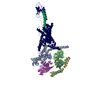 7vvjMC 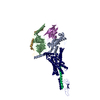 7vvkC 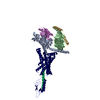 7vvlC 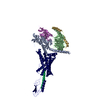 7vvmC 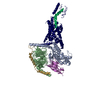 7vvnC 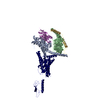 7vvoC M: atomic model generated by this map C: citing same article ( |
|---|---|
| Similar structure data | Similarity search - Function & homology  F&H Search F&H Search |
- Links
Links
| EMDB pages |  EMDB (EBI/PDBe) / EMDB (EBI/PDBe) /  EMDataResource EMDataResource |
|---|---|
| Related items in Molecule of the Month |
- Map
Map
| File |  Download / File: emd_32141.map.gz / Format: CCP4 / Size: 16.8 MB / Type: IMAGE STORED AS FLOATING POINT NUMBER (4 BYTES) Download / File: emd_32141.map.gz / Format: CCP4 / Size: 16.8 MB / Type: IMAGE STORED AS FLOATING POINT NUMBER (4 BYTES) | ||||||||||||||||||||
|---|---|---|---|---|---|---|---|---|---|---|---|---|---|---|---|---|---|---|---|---|---|
| Voxel size | X=Y=Z: 0.96833 Å | ||||||||||||||||||||
| Density |
| ||||||||||||||||||||
| Symmetry | Space group: 1 | ||||||||||||||||||||
| Details | EMDB XML:
|
-Supplemental data
-Mask #1
| File |  emd_32141_msk_1.map emd_32141_msk_1.map | ||||||||||||
|---|---|---|---|---|---|---|---|---|---|---|---|---|---|
| Projections & Slices |
| ||||||||||||
| Density Histograms |
-Additional map: #1
| File | emd_32141_additional_1.map | ||||||||||||
|---|---|---|---|---|---|---|---|---|---|---|---|---|---|
| Projections & Slices |
| ||||||||||||
| Density Histograms |
-Half map: #2
| File | emd_32141_half_map_1.map | ||||||||||||
|---|---|---|---|---|---|---|---|---|---|---|---|---|---|
| Projections & Slices |
| ||||||||||||
| Density Histograms |
-Half map: #1
| File | emd_32141_half_map_2.map | ||||||||||||
|---|---|---|---|---|---|---|---|---|---|---|---|---|---|
| Projections & Slices |
| ||||||||||||
| Density Histograms |
- Sample components
Sample components
+Entire : endogenous ligand-bound the human PTH receptor in complex with Gs
+Supramolecule #1: endogenous ligand-bound the human PTH receptor in complex with Gs
+Supramolecule #2: Guanine nucleotide-binding protein G(s) subunit alpha isoforms short
+Supramolecule #3: Guanine nucleotide-binding protein G(I)/G(S)/G(T) subunit beta-1
+Supramolecule #4: Guanine nucleotide-binding protein G(I)/G(S)/G(O) subunit gamma-2
+Supramolecule #5: nanobody Nb35
+Supramolecule #6: PTHrP
+Supramolecule #7: Parathyroid hormone/parathyroid hormone-related peptide receptor
+Macromolecule #1: Guanine nucleotide-binding protein G(s) subunit alpha isoforms short
+Macromolecule #2: Guanine nucleotide-binding protein G(I)/G(S)/G(T) subunit beta-1
+Macromolecule #3: Guanine nucleotide-binding protein G(I)/G(S)/G(O) subunit gamma-2
+Macromolecule #4: nanobody Nb35
+Macromolecule #5: PTHrP[1-36]
+Macromolecule #6: Parathyroid hormone/parathyroid hormone-related peptide receptor
-Experimental details
-Structure determination
| Method |  cryo EM cryo EM |
|---|---|
 Processing Processing |  single particle reconstruction single particle reconstruction |
| Aggregation state | particle |
- Sample preparation
Sample preparation
| Concentration | 10 mg/mL |
|---|---|
| Buffer | pH: 7.4 |
| Vitrification | Cryogen name: ETHANE |
- Electron microscopy
Electron microscopy
| Microscope | FEI TITAN KRIOS |
|---|---|
| Electron beam | Acceleration voltage: 300 kV / Electron source:  FIELD EMISSION GUN FIELD EMISSION GUN |
| Electron optics | Illumination mode: OTHER / Imaging mode: BRIGHT FIELD Bright-field microscopy / Nominal defocus max: 1.5 µm / Nominal defocus min: 0.8 µm Bright-field microscopy / Nominal defocus max: 1.5 µm / Nominal defocus min: 0.8 µm |
| Image recording | Film or detector model: GATAN K3 (6k x 4k) / Average electron dose: 64.319 e/Å2 |
| Experimental equipment |  Model: Titan Krios / Image courtesy: FEI Company |
 Movie
Movie Controller
Controller
























 Z
Z Y
Y X
X




































